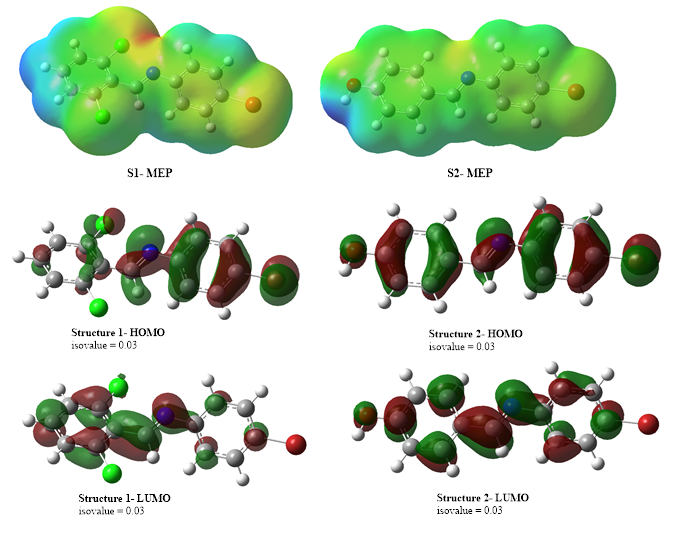Computational investigation and biological activity of selected Schiff bases
Keywords:
Schiff base, DFT, Molecular docking, AntibacterialAbstract
Two Schiff bases, (E)-N-(4-bromophenyl)-1-(2,6-dichlorophenyl)methanimine (S1) and (E)-4-(((4-bromophenyl)imino)methyl)phenol (S2) were synthesized and elucidated using basic spectroscopic methods such as Fourier-transform-infrared, Ultraviolet-visible as well as 1H & 13C-NMR while purity of the compounds was ascertained by the means of elemental analysis. The stability, chemical reactivities and electronic properties of S1 and S2 were evaluated using Density Functional Theory (DFT). Energy band gap (?E) of S1 and S2 are 2.81 eV and 3.02 eV respectively and this inferred that S1 is more reactive as well as less stable than S2. The Molecular electrostatic potential (MEP) mapping evaluation showed that both S1 and S2 are having more of the yellow, green and red region than the blue region, signifying that these structures are prone to electrophilic attack. The compounds were screened against one Gram-negative (Staphylococcus aureus) and two Gram-positive bacteria (Klebsiella pneumoniae and Psedomonas aeruginosa) to evaluate their antibacterial potential. S1 as well as S2 showed antibacterial potential against Staphylococcus aureus and exhibited less of no activity against Klebsiella pneumoniae and Escherichia coli. In silico studies of S1 and S2 against Staphylococcus aureus was carried out and the outcomes corroborate with experimental findings. Pharmacological evaluation of S1 and S2 showed that both compounds exhibited less violation of Lipinski’s rule of five (Ro5) which pose them to be less toxic and orally available.

Published
How to Cite
Issue
Section
Copyright (c) 2024 Segun Oladipo, Adesola A. Adeleke, Abosede A. Badeji, Katherine I. Babalola, Ayomide H. Labulo, Ibrahim Hassan, Sadiq T. Yussuf, Samuel O. Olalekan

This work is licensed under a Creative Commons Attribution 4.0 International License.







